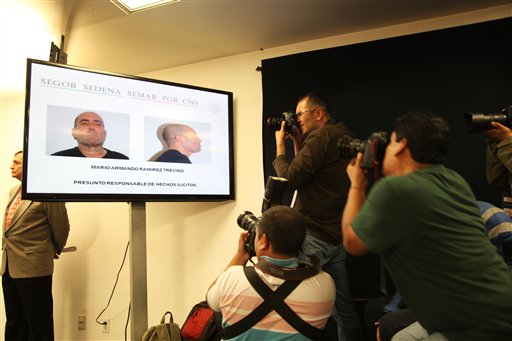By KATHERINE CORCORAN
Associated Press
MEXICO CITY
With the capture of two top drug lords in little more than a month, the new government of President Enrique Pena Nieto is following an old strategy it openly criticized for causing more violence and crime.
Mario Armando Ramirez Trevino, a top leader of Mexico’s Gulf Cartel, was detained Saturday in a military operation near the Texas border, just weeks after the arrest of the leader of the brutal Zetas cartel near another border city, Nuevo Laredo.
Interior Secretary Miguel Angel Osorio Chong took his post in December saying the strategy of former President Felipe Calderon to take out cartel leaders only made drug gangs more dangerous and violent. The new administration would focus less on leaders and more on reducing violence, he said.
Yet the new strategy appears almost identical to the old. The captures of Ramirez and top Zeta Miguel Angel Trevino Morales could cause a new spike in violence with battles over leadership of Mexico’s two major cartels.
Federal security spokesman Eduardo Sanchez insisted at a news conference Sunday that there have been key changes in strategy. Most important, he said, is an unprecedented coordination among security entities, including federal police, the attorney general, branches of the military and state governments.
Sanchez said the government expects a readjustment in the cartels with the new vacuum in leadership and has put forces in place in Tamaulipas to help prevent that. He would not say who the government thinks will take over the Gulf cartel.
Ramirez, 52, a drug boss in Reynosa, across the border from McAllen, Texas, had been vying to take over the cartel since the arrest of the gang’s top capo, Jorge Eduardo Costilla Sanchez, alias “El Coss,” last September. Some say Ramirez succeeded by reportedly killing his main Gulf rival, Miguel Villarreal, known as “Gringo Mike,” in a gunbattle in March. Villarreal’s death is still disputed by some.
The U.S. State Department has offered a reward of $5 million for the capture of Ramirez for several federal drug violations. Sanchez said he didn’t know of any extradition request, but that authorities are checking.
The once-powerful Gulf cartel still controls most of the cocaine and marijuana trafficking through the Matamoros corridor across the border from Brownsville, Texas, and has an international reach into Central America and beyond. But the cartel has been plagued by infighting since Costilla’s arrest, while also being under attack in its home territory by its former security arm, the Zetas.
The split is blamed for much of the violence in Reynosa, where there have been regular, public shootouts between Gulf factions and authorities the last six months. The factions are willing to fight for the largest piece of the lucrative business of transporting illegal drugs to the biggest market, the United States. Mexico continues to be the No. 1 foreign supplier of marijuana and methamphetamines to the U.S. An estimated 93 percent of South American cocaine headed to the U.S. travels through Mexico, according to 2010 FBI statistics.
Before leaving office, Calderon repeatedly touted the fact that his forces had captured 25 of Mexico’s 37 most-wanted drug lords, a strategy backed by the U.S. government with hundreds of millions of dollars in funding and close cooperation with American law-enforcement, military and intelligence agencies.
With that strategy, Osorio Chong said the cartels had dispersed their leadership which “has made them more violent and much more dangerous.”
The new government also said it was going to limit the widespread and casual access that U.S. agents had to Mexican forces under Calderon.
But security analysts agree that close cooperation between the Mexican military and the U.S. continues along the border, despite messages from Mexico City. The coordinated efforts to track and capture Zeta leader Trevino started under Calderon and continued, said George Grayson, a College of William & Mary professor who has written extensively on the Gulf and Zetas cartels.
Sanchez said Sunday that no intelligence or data from any other country was used in the capture of Ramirez. He offered no details of the operation, but said the arrests of 24 of Ramirez’s associates Aug. 12 added to the information the government already had collected in tracking the cartel boss’s whereabouts.
But, Grayson said, the government hasn’t been able to get drug violence out of the headlines because of the fighting along the border and in states like Michoacan, where two other cartels are battling over territory.
The new administration’s tactic in Michoacan also has mirrored that of Calderon: sending more troops and federal police to try to regain control, even while saying the focus is on crime prevention to bring down violence.

COMMENTS
Please let us know if you're having issues with commenting.